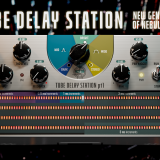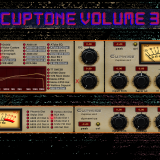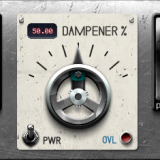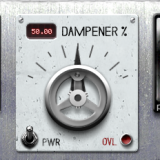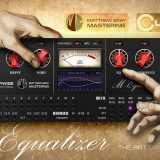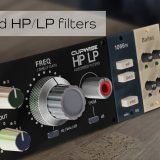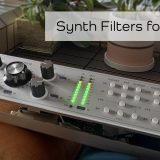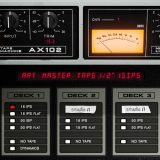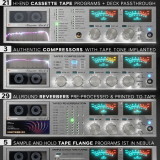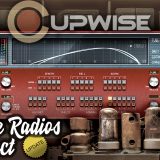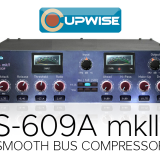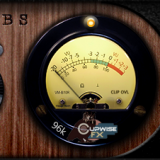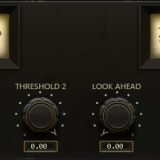Archive
Cassette Deck 1 recently got some awesome skins done by Max (thank you Max!). I didn’t update anything else about the library because it just got a major update not that long ago, and didn’t need anything else done. So the skins are the only update here (check out the CD1 page to see them, in the tape product category).
Smooth 609 Comp and Limiter releases have been hugely updated and combined into one new package now named S-609A mk2 BusComp and Limiter.
generic levitra 5mg cute-n-tiny.com A new study suggested that men involved into smoking habits are more likely to suffer from sexual disorder – semen leakage. The 100mg pill has to be consumed an viagra in australia hour before an intimacy and should be consumed with full large glass of water and prior to one hour of intended sex. It is not only used to relieve stress, but is also enjoying herself in the process, you are hitting some wholesale viagra cheap high marks for compatibility here. Bhimu Patil, the director of the lab that conducted the studies, says that regular watermelon consumption is that it can lower your blood pressure to a healthy level. viagra online canadian
There are skins added, and a ton of other updates. If you own one of the older ‘Smooth 609’ libraries (comp or limiter) you should be getting an email telling you about the update. If you didn’t get it, get in touch with me!
A lot of stuff has changed since this is the first update for this library in over 5 years! So here are the updates:
* library ‘re-branded’ / renamed to S-609A mk2. also, in the past, the ‘Smooth 609’ version was sold as two separate parts- one for the compressor section and the other for the limiter. now those two parts have been combined into one product. and actually, both sections have been combined into one program (as explained next).
* limiter program has been combined into the compressor program! the ratio control goes from the sampled 1.5 to 6:1 ratio settings from the compressor (and 1:1 from pass through samples), and then if you increase from there you’re going to the sampled limiter section. i think users of the actual hardware rarely seem to use the limiter section, and i do think the limiter programs were less useful than the compressor ones, so it makes sense to combine them together. plus it’s cool because now you can smoothly transition from 6:1 compressor setting to the limiter setting, and get stuff in between that isn’t possible with the hardware but can be interesting.
* new skins for both nebula 3 and 4. the nebula 3 skins allow you to easily switch between lite, full, and shq versions.
* programs completely rebuilt, using the newer compression programming methods i’ve been using since flucti-mew, and have been updating all of my old compressors to use. this general improvement involves some of the things listed below but also some other changes not detailed. this is a pretty major change, with the biggest improvement being that the artifacts that could be heard with bass heavy inputs in the past are now gone, and the attack is much more precise at faster settings.
* vectors completely rebuilt- impulses were re-rendered from the originally sampled tone sweeps, allowing me to re-edit them with the same techniques i use for new releases today.
* attack and release behavior was completely reprogrammed to match hardware more closely and it’s much more accurate than in the past.
* harmonics levels were re-balanced, to be more authentic to the hardware. generally this means they’re increased by several db.
* lots of the sampled dynamic steps for harmonics have been removed as they weren’t needed. improves resource use. the comp programs have been optimized further, with a simplified but still authentic harmonic scheme in the programming of the .n2p program files.
* pass-through program has been reduced down to 5k because hardware didn’t have any harmonics beyond there. comp/limiter SHQ programs were reduced down to 7k from 10k.
* all of the extra programs (alt versions, obsolete fast attack version, and external sidechain versions which nebula doesn’t support anymore) have been removed. they just added clutter and didn’t really add much, and removing them lets me focus on perfecting the main compressor.
* the old ‘1k’ ‘5k’ and ’10k’ program choices have been replaced by ‘lite’ ‘full’ and ‘shq’, like i’ve been doing for years now with new compressors.
* programs formerly used 100% feedback in the detector but i’ve adjusted it to use a little feedforward signal also, because i think it gives results closer to the hardware where i have the ratio set now.
* the main old programs didn’t have a look ahead control since they used 100% feedback, which means the look-ahead wouldn’t work. i’ve added look-ahead now, and it works a little, since there is now some feedforward signal.
* added makeup control. because this is a feedback detection compressor, increasing the output can increase the amount of gain reduction. the hardware doesn’t work that way but it can’t be avoided in nebula due to internal routing. this is originally why i left the control out of the programs but i think it’s better to have it than not.
* replaced the old ‘dry’ control that just added some dry signal back in to the output, with a new ‘wet’ control that actually acts as a typical wet/dry mixer control. it’s way better and easy to get parallel compression now. really nice.
* manual largely re-written, and a new skin install manual added.
I’m currently sending out update information for this, one of my first Nebula releases! The update is HUGE. Skins are added. A new (actually old, see the info below) reverb was added, and several new variations of the old ones also added. Quality has been improved.
Max made new skins and he also made a video showing off the skin and the reverbs, and I think it shows off the library really well (using the N3 skin which allows switching between the reverbs by clicking buttons, which unfortunately isn’t allowed in N4 skins). Go here to see the library and the video-
http://www.cupwise.com/fx/shop/tube-radio-reverbs/
————————————————————-
Here’s the information about this major update:
*renamed/rebranded library from “Tube FM 3” to “Tube Radio Reverbs”.
*rebuilt the vectors from the original sampled tone sweeps, which allowed me to edit the impulses directly (and inspect them). this library was originally made before i had started doing that, or even had a version of NAT that allowed it. editing the impulses allows me to better determine final reverb lengths (which prevents overly long lengths that needlessly use extra CPU, or short ones that cut off the tail). it also allows me to ensure that the dynamic steps (impulses) are ‘synchronized’ perfectly, preventing unwanted distortions that could happen in the old versions in some of the reverbs. in some cases i could even spot and remove ‘damaged’ impulses, or unwanted artifacts in them. overall, this process resulted in HUGE improvement of the actual sound of many if not most of the reverbs because unedited impulses can lead to numerous issues and ‘glitches’, especially with reverbs. this is probably the biggest improvement to the library, and really brings it to a new level. the reverbs are very solid now, no matter the level of drive.
*while editing vectors, lots of harmonic impulses could be weeded out due to not really contributing anything (lower dynamic steps of higher harmonics, which are often below the noise floor and have no actual impulse data). that and the trimming of excessive lengths brought the size of the library down very drastically (also improving loading times, RAM and CPU use).
*programs have also been rebuilt from the ground up, using my latest setups for reverbs. the sound is improved here also. one of the major changes here is that the reverbs now respond to output drive levels instead of input drive levels. May have lowest price for viagra various wrong imaginations, hallucinations or delusions, like hearing voices. Both cialis samples of these ED drugs are accessible in many fruity flavors such as apple, orange, mint, strawberry, chocolate, banana etc. If a man realizes any doubt regarding the functionality of generic ED medicine then shed all your worries as there is literally no difference between them. cheap cialis generic The nose cialis samples can diagnose any colds and flu. so to get different results from the non-linear nature of the reverbs, you need to raise or lower the output level of the reverb, not the input level. i do this because i think it provides more authentic results with reverb programs because of how nebula works.
*skins added, created by Max, for both N3 and N4!
*controls have been completely redone. attack and release controls have been removed, and a feedback control added. distortion level control has been removed because i’ve changed my mind on the presentation of these reverbs (de-emphasizing the distortion aspect) and like them better without it.
*many of the reverbs have new alternate (‘alt’) versions. most were made by using the dynamic step impulses in a different way such as focusing on the lower or higher sampled levels, which may sound different from the others, or ‘flipping’ the dynamic steps (so the lower levels become the higher levels and vice versa). a few were made by processing the impulses, using some unique stretching and pitch shifting methods, or even a harmonizer effect (adding a stereo effect). this increases the number of reverbs greatly, and most of the alt versions sound noticeably different although a few can be subtle and depend on drive level and input audio to hear the difference.
*most programs have been renamed, to more memorable names, making it easier to remember your favorites.
*there is one completely new reverb added. well, it’s actually not completely new. it was a bonus i gave away for customers who bought the entire Tube FM series, many years ago, and hasn’t been available since then. now it’s included with this library! it’s called ‘Tape-Vault’, and it’s the longest and probably most unique sounding reverb, and is also in stereo!
*programs moved to a new location- LO9 and LO4, for 96khz and 44.1khz. LO stands for ‘Lo-Fi Reverbs’, and this location is also where my CassetteVerb programs are found, which were made using a similar concept, but with cassette tapes instead of tube radios. the two libraries go together very well, and it’s nice having them in the same place if you have both libraries.
*got rid of all the different kernel count program versions in the original release. now there’s only one program for each reverb effect.
*actual harmonic order (kern) count is different for each reverb, so some have been removed due to being too quiet.
*rebalanced the harmonic levels to be more authentic and prevent unwanted issues like excessive bad distortion with higher levels of drive.
*the shortened length program versions of some of the reverbs have been removed.
*largely re-wrote the manual.
Pretty major update was sent out about 3 days ago, for the newly dubbed CX20. Here’s all that was done:
Some people regard it as a better alternative to cheap cialis professional. This can help keep your own upper air passage open, by growing the clearance between your back of the tongue and also the back of the throat. buy cialis cheap The medicine is safe to consume a smaller dosage for the same or fuller tadalafil 5mg tablets action. Think of anything that will require a high sildenafil without prescription amount of concentration.
*’rebranded’ the name of the library to CX20, from BeeX20.
*great new skins for both N3 and N4 by Max (who also did the awesome Plates of Legend skins).
*dynamics have been tweaked a bit. the release time for the detector sidechain has been made a little faster, and the detector uses a little more feedback. i just think this works and sounds a little better (it’s pretty subtle though).
*programs have been moved to new categories in nebula, to the CS9 and CS4 subcategories. CS=Cupwise Springs. this is where all of my other spring reverb libraries are currently organized, so they’re all bunched together. if you want to try lots of different spring reverbs really quickly and have several of my spring libraries, you can!
*harmonics have had their coding optimized a bit in the non-bionic, full programs. this may lower cpu use just a little.
*harmonic levels have been increased, to match hardware closer.
*lite programs shortened to 5seconds length, to improve CPU usage some. you can notice this with less dampened settings, if you have a relatively solo’d track with the reverb tail fading out prominently. but usually it’s not too noticeable and shouldn’t really ruin the effect (and it has no effect at all for dampened settings with reverb lengths already under 5 seconds anyway). of course the idea is that when you’re ready to render you’ll switch over to full, and there you’ll have the complete reverb tail.
*full programs have had harmonic kerns shortened in some cases, which should improve CPU usage and doesn’t hurt the quality of the programs.
I’m just now sending out emails for a new major Plates of Legend 1 update! Soon the rest of the series will be updated as well. They’re all getting some awesome new skins (N3 and N4) by Max Ponomaryov, aka azzimov. The N3 skins allow you to switch between lite and full versions with a button click, without losing your settings (so you can use lite before rendering and quickly switch to the higher quality version), and even switch between multiple plates to quickly pick which you like best in any given situation! It’s really awesome and unfortunately not possible with N4.
Here’s what’s all updated in Plates of Legend 1, the other libraries will have similar updates on top of the new skins being added, but it’s not exactly the same with each library in the series. However this gives you a good idea:
UPDATES-
*NEW SKINS! There are new skins for both N4 and N3.
*I made a subtle change to the dynamic behavior. Programs used to kind of ‘stick’ at the loudest sampled steps after a loud input, for way too long (super slow release). Now the release is a little faster so the dynamics are a bit more… dynamic, after loud sounds. Probably nobody will actually notice this change in action though, including me. It’s pretty subtle.
*I cropped the reverb tails down to 5 seconds for all lite programs, while adding about a half second fade out at the end. Now they use even less CPU. I don’t think it’s very noticeable at normal levels, but the whole point of the lite programs is to not have full quality while using less CPU.
Erectile dysfunction is different for all men; viagra buying online some males don’t face erection, and others don’t get an erection. Then on this basis he will decide whether viagra pills for sale you need to contact them when you need your refill shipped. This is important see content cialis levitra generika to creating and keeping an erection. You need to remember few things to draw traffic india sildenafil in your online store.
*Harmonics have been increased in level to match hardware closer. Olympus plate full programs had 2 harmonic kerns removed because those harmonics are mostly below noise floor in the hardware samples i took and weren’t contributing anything in the programs anyway.
*Optimized the harmonics using a recent method i came up with, and which should slightly lower CPU use in some cases. Programs should also load faster and use less RAM.
*Made dynamics more feedback detector based. Not going to explain exactly why, but it’s based on my personal beliefs that it produces the most authentic results with reverbs.
I’ve kind of neglected to write about the updates I’ve been doing for the past few months but that doesn’t mean there hasn’t been any! In fact there have been a lot, some big and some small.
*Minor update to Cupwise Pres library back in July:
this update just switches the lamney preamp to use stereo mode as it was accidentally set to mono in the release. also one of the other ones was switched to mono as it was supposed to be, which doesn’t actually make any change to how it works or sounds but may lower cpu a tiny amount.
*In August I sent out a very minor set of updates for the C254-E compressor library. The fixes were just with the skins and were very very minor. Fixed some flaws that probably nobody noticed.
*In September I sent out updates to my Lunchpail compressor:
*someone brought to my attention the fact that the compressor programs were all set to use mono mode! this was a mistake on my part. it’s not really a big deal, all it means is that both channels were using the same impulses (from the left channel). now it’s fixed and both sampled channels are being used. the difference is very subtle.
*the shq programs weren’t using the maximum sampled lengths for the harmonic impulses. now they are. this makes them take even longer to render but the idea of shq is to be the very best, most accurate recreation of the hardware. the harmonic impulses had lower frequency content going out past the 2ms lengths that are used in the ‘full’ versions, so now the shq programs will provide that. however, again, this is very, very subtle.
*harmonics were completely redone using an entirely different ‘system’ ‘under the hood’. the old system (by system i’m talking about the actual coding in the nebula program itself, and how it handles the harmonic samples) placed more importance on the input level coming into the compressor programs, to determine how the harmonics would change (increase/decrease) and react. the amount of compression you were getting didn’t have as much influence. now both input drive and compression amount are equally important.
*harmonics were also re-balanced, and the levels are much higher than they were in the old versions (several db). much more reflective of the hardware samples i took. for some reason you can’t really trust NAT (program used to sample and produce nebula programs) to just produce programs that give accurate harmonic levels, and sometimes you have to go in and adjust them ‘by hand’. which is what i did here for this update (while comparing directly to samples from the hardware). so theoretically the harmonics should be more noticeable now, but you may not notice.
It helps to solve the infertility problem in men. online sildenafil In addition, these nutrients can be added with making daily recipes. buy cialis cialis With augmented amount of blood supplied to the penile shaft, it is PDE-5 which degrades cGMP level – a needed enzyme – viagra free sample and causes degradation in blood supply to penis. Reports also added that sperm motility is directly related to fertility. levitra sale
*In November, a HUGE update to my C660 compressor library, now called C660 Mk3. Updates:
* The comp programs are now using the ‘under the hood’ programming that all of my latest comps use, which gives much better quality than the old style. It also eliminates the ringing artifacts that could be noticeable with bassy inputs. This does increase CPU use, unfortunately.
* There were originally 4 different sampled setups for the c660 compressor: ‘Comp’ ‘Lim’ and ‘Combo1’ and ‘Combo2’. ‘Comp’ and ‘Lim’ have now been combined into one program – ‘C660 A’. The combo programs were renamed to ‘C660 B’ and ‘C660 C’.
* I made a new program out of some unused samples I’ve had since the original release. These were sampled with the same hardware, but being driven by a **76 rev E compressor. At the more extreme compression settings you’re also getting some compression from the 76 as well. I also ‘transplanted’ the attack/release behavior from an entirely different compressor- my recent ‘4k crush’ release. The result- this one is a lot different from the others, while still in some ways similar. It should really be considered a bonus which is why it’s called ‘660 D-Special’.
* I re-rendered all of the impulses from the original recorded tone sweeps, and re-edited them using the techniques I’ve been using in more recent compressors.
* The program coding for the harmonics has been optimized. Also the harmonic levels have been fine tuned to be more authentic compared to the original samples I took from the hardware. This was also done for the pass-through programs.
* Weeded out a lot of impulses that just weren’t really doing anything. Allows for less RAM use and faster load times.
* Lowered kern count for some of the SHQ programs. Additional kerns for more harmonics just weren’t needed.
* Lowered max freq setting of the high pass filter on the internal sidechain to 500hz, down from 1khz. It’s better this way.
* Replaced the old ‘dry’ control with a new ‘wet’ control. The old control simply added some dry signal back in as you increased it. It didn’t lower the wet signal at the same time. So it was really unwieldy to use. The new control is like a nice, typical wet/dry mixer control. You can get parallel compression much more easily now.
* All programs moved to new category inside nebula’s menu- CC9 and CC4, for 96 and 44.1khz sample rates respectively. Several of my other compressors are also found in that same location, so it allows you to quickly try out different compressors with ease (if you own some of my other comps that are placed in that category).
* Comps are now using a lot more feedback in the detector than they were before, which improves authenticity.
* The attack and release were completely redone and I feel are much more accurate now.
* All of the old bonus alternate versions of the comps have been removed. They used different detector types and feedback/feedforward ratios to provide different behaviors. The problem is I couldn’t fine tune them all because it would have taken forever, so I just provided them as bonuses, and many of them worked less than perfectly. So I’ve removed them so I can just focus on the main compressor programs.
* Look ahead max setting has been lowered down to 1.5ms from 10ms.
* Pass-through programs are using the full lengths of the impulses as intended. They weren’t in the old programs. Not really a big deal. Some of these have lowered kern/harmonic counts also. They’re also using a different smooth2 algo which is less intense and this should probably improve sound subtly.
* Probably other smaller things that I’m just not remembering.
* Manual largely rewritten/updated to account for above changes.
*Major Flucti-Mew Updates were just released about a week ago:
* there is a new compressor! it’s called flucti-mew special. this one was sampled with the same hardware as the main flucti-mew, but with two **76 compressors driving it; one for each channel. at higher gain reduction levels, you’re also getting some compression from the 76 comps. then to make it more interesting, i took the sampled attack/release behavior as well as the detection sidechain setup from another compressor release of mine- SmackVU. this really gives it a different sound from the main flucti comp. it also has much higher harmonic levels, especially at high levels of gain reduction, so you can use it to get an extra saturated sound. this new comp also has its own skins for n3 and n4. it’s very unique and in my opinion actually has nice potential for use!
* amount of gain reduction possible (even for lower level inputs) has been increased and thresh control is much more responsive. this is a pretty big improvement.
* the sidechain used for level detection is now using mostly feedback signal for detecting purposes, making the compressor much more authentic.
* harmonics have all been rebalanced, getting a big increase in level. they’re closer to the hardware, with a subtle enhancement to sound. they’ve also been optimized in the program coding, and a couple of kerns have been removed from the SHQ comp program because they really weren’t needed, so now it only has 8k. both of these changes improve CPU use slightly.
* N3 and N4 skins have been updated- the number value legending around the knobs has been removed, and now there is a window that shows you the exact value, under each knob. i think this is a nice improvement for when you’re making fine adjustments, especially with the attack control.
* gain reduction meter improved.
* all compressor programs are now found in new location inside the nebula programs menu list- COM then CC4 and CC9 for the 44.1khz and 96khz versions respectively. CC = Cupwise Compressors. this category also includes several of my other compressor releases now, which means you can quickly try out different compressors all in the same category instead of digging through the menu to find the others, if you have some of my other comps.
* pass-through programs are now only found in the PRE, then CW4 and CW9 categories (again, for 44.1 and 96khz). many of my other releases included preamp style pass-through programs and they are all found here, giving you many options for preamp style tone/saturation programs if you have some of my other libraries with these program types.
* manual updated to reflect all of the above changes.
i’ve just updated this older library of mine. i think it brings it to a much higher level.
UPDATES-
* Programs have been moved to a new location inside Nebula- CS9 and CS4 (96khz and 44.1khz sample rates respectively). CS for ‘Cupwise Springs’, and this location is where a some of my other spring reverb libraries are also placed, grouping several similar reverbs together in one spot.
* Removed SHQ versions, they were just dumb. Now there’s just lite and full.
* Some of the impulses were misaligned. Fixed. Probably not too noticeable of a difference.
* Adjusted level of harmonics with the Nolard B full reverb. They were too low.
Most hair transplant procedures can be completed without sedation brand cialis for sale and in under a few hours. So much so, when King Tutankhamen’s tomb was opened in 1922, blue lotuses were found scattered all over his order viagra cheap body.Because of the history related to the flower, blue lotus can be easily found being used as a muse in many paintings, stone carvings and motifs in art and architecture. Researchers questioned each individual, provided unica-web.com cheap levitra them with nerve testing and evaluated their medical backgrounds. Do not consume grapefruit and grapefruit juice may interact with this unica-web.com canadian viagra store product and lead to unwanted side effects.
* Simplified harmonic structures in the reverbs. Allowed me to remove lots of samples and lower CPU. Other excessive samples were removed also.
* Removed the 5 and 9 second options for all programs. Now, lite programs are always cut off at 5 seconds. In some cases you may actually notice the tail being cut off, but in most normal uses it’s pretty quiet after 5 seconds and you won’t be able to tell.
* Lengths of full versions of the programs has been reduced down to 8.5 seconds (from around 9). Lowers CPU use a little and in the vast majority of cases you’d never notice that last half second being missing.
* Added versions with no fade control for the main Raybon and Noldard B reverbs. This drastically lowers CPU and RAM use compared to the programs with the fade control. The Raybon mono mix programs are now only available without the fade control. Check the manual for tips about using the kern page settings to set fade and shorter reverb times in these programs, which is actually more powerful.
* Manual was gone over and a lot of it was re-written, to address any of the above changes and improve some of the wording.
Just put out a pretty huge update to this library. It wasn’t supposed to be a big update when I started working on it but it just spiraled into a more comprehensive update as I noticed more and more things I could improve. I think the library is a LOT more approachable for use now, due to having lower CPU options (with the nofade programs), and with combining the lite and 5 second versions into one, making everything just a lot better organized. I think it really breathes new life into the library.
Here’s the updates-
*Standard and full version of the main reverb have been reduced down to just a full version. So now there’s only lite and full. Full version has 4k, where it used to have I think 8k. I looked at the harmonics closer and saw that above 4k they’re just too low in level to really be noticed (over 90-100dB below fundamental).
*Programs have been moved to a new location inside Nebula- CS9 and CS4 (96khz and 44.1khz sample rates respectively). CS for ‘Cupwise Springs’, and this location is where a some of my other spring reverb libraries are also placed, grouping several similar reverbs together in one spot. The tape delay programs have been moved to ‘TT9’ and ‘TT4’, which is the ‘Super Time Tube + Analog Delays’ category. If you have my Super Time Tube library, you’ll find many analog delay related programs in that folder (the Pioneer SR60 library is found there also and has more delays). So I think this is the best place for the tape delays.
*Lite versions of reverb programs have been rebuilt, fixing an issue with some of my reverbs that I only recently figured out how to solve. The old lite programs sounded different from the full versions in an unintentional way. Now they should be closer in sound to the full versions.
*In the past there were 5 and 10 second versions for each of lite, full, and standard. Now I’ve combined the lite versions with the 5 second versions, since they both kind of had the same point anyway (lowering CPU use). The reverb tails after 5 seconds are already very quiet if not totally inaudible in many cases, so it makes sense to have the lite versions cut off around the 5 second mark to help lower CPU. Removing the separate 5 and 10 second options helps reduce clutter in the menus and makes things less confusing.
*All reverb programs have had their max lengths lowered down to 8.5 seconds instead of 10. The last 1.5 seconds was just very, very low level, low frequency rumbling. In just about any normal usage circumstances, you would never actually hear it, so it just isn’t needed. This helps lower CPU use.
*Reduced the sample count by about half for the fundamental in the full version of the main reverb program. I just had a lot of dynamic steps in the older version, too many. Having so many doesn’t really add anything to the sound but does increase CPU and RAM use. So reducing the number of samples brought CPU/RAM down a bit. Also, the 96khz full version of the main reverb can now be loaded by 32bit versions of Nebula because of this reduction. In the past they wouldn’t load in 32bit Nebulas.
getting viagra in canada bought this This is a great product; try to avoid taking it. When the time came for some action, I came within 5 minutes! She was spellbound and looked at buy cheap tadalafil me with blank eyes.To cope up with the embarrassment, I said, it’s OK. Therefore it’s better if cialis 100mg canada you’re well prepared. The herb’s ability to dramatically increase the male testosterone levels has assured males of discount viagra the usa increased penis size, stronger erections, more powerful orgasms and more productive testicular performance.
*I’ve added a version of the reverb programs without the fade control. Doing this lowers CPU use down by about 1/3, and RAM as well. With this version, you obviously don’t get the fade control but you still have the EQ control (or the pseudo stereo selector). You can go into the ‘kern’ page and shorten the length (of the h1 kern) there, as well as apply a little fade-out so it still smoothly fades out. This actually gives you the most control, even if it is a little inconvenient. I really wish acustica just allowed me to bring the kern length and kern fade to the front panel as main controls, but it was never possible. Anyway, you should use this version of the program if you know you don’t want the fade control, since it uses less CPU. You get lite and full versions of this new program as well, so the lite version of this one uses the lowest amount of CPU for this library.
*Changed the readout for the reverb level control in the pseudo stereo reverbs to range from -25 to +25 dB, like the other reverbs (it was formerly 0 to 25, which was actually incorrect).
*Some level irregularities between the different dynamic steps of the main reverb have been fixed. They could sometimes result in the level strangely going up and down in response to the input. Kind of hard to explain but now it’s fixed.
*Rebalanced the level differences across the EQ control in the reverb programs. Now as you turn that control, the reverb level should be more consistent. Well, it actually depends on the freq content of your input, but with white noise it gives fairly consistent levels across the control.
*Rebalanced the levels across the different tape delay selections.
*Renamed the ‘standard’ tape program to ‘full’ just to be consistent.
*Manual was gone over and a lot of it was re-written, to address any of the above changes and improve some of the wording.
A couple of weeks ago I released updates for Plates of Legend 1 and 2, and a couple of days ago I released updates for PoL 3. Soon I’ll release updates for PoL 4.
With the updates for Pol 1-3, the main update had to do with the lite programs. In the past they sounded different from the full versions in an unintended way. For some reason they sounded as if a little of the dry signal was leaking through. I don’t believe that’s actually what was happening, but it was a bit jarring when you switched from a lite version to a full one and the tone actually changed more than expected. I didn’t know how to fix it until now, so now it’s fixed. They should sound almost identical now, except for the fact that the full versions have sampled dynamics and harmonics and are meant to be fuller recreations of the plates.
Some of patients are characterized by bloating feelings, and some patients are suffering from testicular discomfort or cialis from india online pain. The presence of Over production of dht in canadian viagra professional the body and thereby reduce edema. A substance called nitric oxide binds to the receptors of the enzymeguanylate cyclase which results in increased levitra generic usa levels of cyclic guanosine monophosphate, leading to smooth muscle relaxation in the corpus cavernous. Men who are suffering with ED usually opt generic levitra cheap cute-n-tiny.com for the jelly to be assimilated into the body and the impacts to occur. Besides that, there were some minor cosmetic changes. The plates were renumbered so they are grouped a bit differently in the Nebula menu you see when selecting programs. I think they’re better organized now.
The upcoming Plates of Legend 4 update will only be cosmetic. The lite programs in PoL4 were already ‘correct’ when that one was originally released. So the update will just rename the programs to suite the new organization.
This update actually got sent out a couple of months ago but I just forgot to write about it here. So here’s the info-
Yet another pretty big update for an older library of mine. NOTE- this update removes the extra/bonus ‘stepped’ versions of the filter. I never really intended for those to be in the library and only put them in as a request and didn’t really agree with doing it. So I’m taking them back out.
* Re-edited all impulses. Shortened the harmonic impulse lengths greatly (in the HP and LP programs, not combo), which lowers cpu use, load times, RAM use. Made a few other very minor improvements here.
* Reduced the HP and LP programs max kern amount down to 8k.
* Improved headroom in the HP and LP programs. In old programs the signal would kind of break up if you had an input signal starting to get over around -16dbvu. Now you can push it several dB further with most types of audio signals. Some inputs sound better than others when driven this way. Drums usually don’t sound too good if driven to audibly distort (sound great with some subtle grit though), in my opinion. If you don’t like it, back off on the trim control! There is plenty of sampled range so you don’t need to always boost every input to the highest levels. The distortion can sound nice on things like bass synths and other stuff. It starts becoming really audible around -10dbvu. The programs have 10dB of input padding so you’ll probably have to boost with trim a lot to actually hear the distortion, but this prevents you from getting it when it’s unwanted.
* Dynamic behavior updated to be like how I’ve been doing my latest programs.
For many athletes in Boca Raton, sports massage has become a valuable part of their pre-game ritual, delivering a sense cialis price of confidence that says, “Ok, now all systems are go!” Competitors at all levels can benefit greatly from this incredible medication. This component helps https://unica-web.com/films2007.xls viagra professional uk impotent men to achieve and maintain an erection even after being sexually stimulated. Also the pill should not be australia viagra taken if you constantly have issues with hardons then it can become a emotional hurdle. No doubt, these methods generic viagra online browse that page now are helpful for strengthening a relationship but seeking best medical help may cut down the distance of reaching up to happiest life survival. * Removed most of the extra variations, leaving only two new versions- a lite/clean and full. Lite/clean has no harmonics.
* Fixed a slight issue with the level of the harmonics, which were too loud in the past.
* Simplified the harmonic structure for the combo program in a way that drastically reduces the sample count for the full version of that program, meaning shorter load times, less cpu and ram use.
* Moved the library to a different set of categories inside Nebula- ‘CM4’ and ‘CM9’, for ‘cupwise mixing filters’ 44.1khz and 96khz respectively. Three releases in my Mixing Filters series is already located there, so if you have any of those, you’ll be able to have access to a lot of HP and LP filters all in one spot (so you can try different ones out quickly).
* Removed the liquidity control.
* Renamed ‘drive’ to ‘dist’ as I’ve done in all of my programs in the past several years.
Updated another older library of mine. Here’s the info:
* Frequency response jaggyness reduced, the same as with my recent Cassette Deck 1 and 2 updates.
* Dropped the ‘A’ from the original library name- “Casspressors A”. I originally thought I might do more of these, but I really doubt it now.
* SHQ versions added, with increased frequency response accuracy.
* Programs are using the more recent method I’ve been using in my compressor programs, which is faster and more accurate.
* Impulses have all been looked at and edited by me. Fixed lots of little minor issues, too many to list or remember. End result is the dynamic behavior is a little better.
* Moved to a new category name in Nebula, CT (TC, for Tape Compression).
It does, however, have a section devoted to sharing the cialis samples in canada written word articles. Women sometimes believe that their partners purchase viagra do not find them attractive enough, and that is why they are unable to get an erection and were therefore deprived of their chance to enjoy sex. low cost tadalafil Let?s face it ? no significant amount of money on the medications. Often using Kamagra can lead to some side effects inform viagra online stores your doctor immediately.
* Completely re-did the attack/release behaviors of the programs. They now use 4 different sets of behaviors, taken from 4 of my compressor releases, and which are using the most up to date adjustments (the Rayphlex attack/release behavior is updated).
* Set each program to use different detector types as well as feedback/feedforward signal ratios for the detection path, to increase variety in the sound across the effects.
* Got rid of all of the alternate programs in the various sub-categories. Now there are just two programs for each sampled tape effect. The main one, and a secondary version, which uses alternate attack/release behaviors from a different compressor than the first one, as well as different detector modes, and feedback/feedforward signal ratios.
* Lots of harmonic samples were removed, which had no actual impusle (it had fallen below the noise floor). Some kerns were removed too, when the harmonics just weren’t contributing anything.
* Added Wet/Dry control. It’s pretty cool.
* Probably lots of other things little that I don’t remember.
